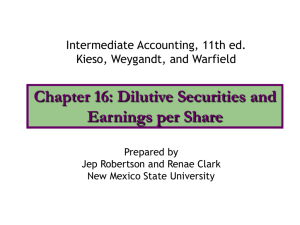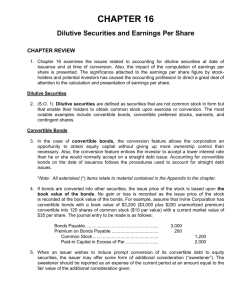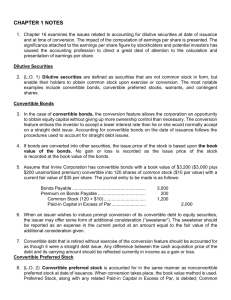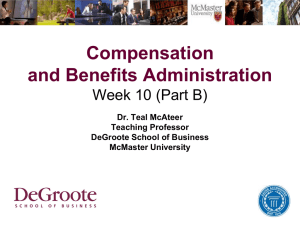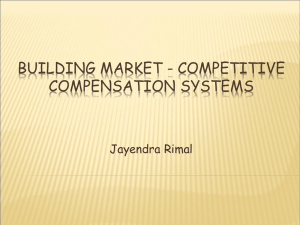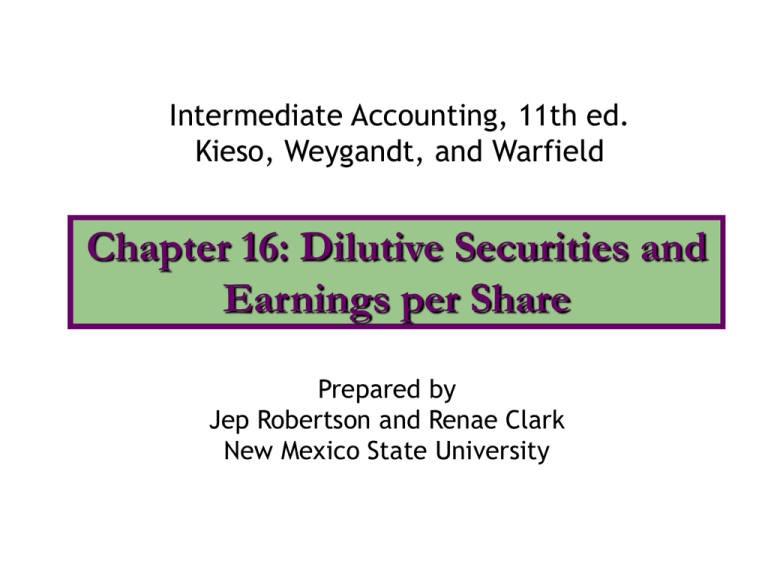
Intermediate Accounting, 11th ed.
Kieso, Weygandt, and Warfield
Chapter 16: Dilutive Securities and
Earnings per Share
Prepared by
Jep Robertson and Renae Clark
New Mexico State University
Chapter 16: Dilutive Securities and
Earnings per Share
After studying this chapter, you should
be able to:
1.
2.
3.
4.
Describe the accounting for the issuance,
conversion, and retirement of convertible
securities.
Explain the accounting for convertible preferred
stock.
Contrast the accounting for stock warrants and
for stock warrants issued with other securities.
Describe the accounting for stock compensation
plans under generally accepted accounting
principles.
Chapter 16: Dilutive Securities and
Earnings per Share
5. Explain the controversy involving stock
compensation plans.
6. Compute earnings per share in a simple
capital structure.
7. Compute earnings per share in a complex
capital structure.
Convertible Bonds: Concepts
• At issuance: parallels accounting for
straight debt.
• At conversion, typically the book value
of the bonds is removed and replaced
with common stock.
• Cost of induced conversions is a period
expense.
• Conversion is initiated by security
holder.
Conversion of Debt: Example
Given:
• One $1,000 bond, issued at $45
premium
• The bond is convertible into 10
common shares of $10 par
• At conversion: unamortized premium is
$30
Record the conversion using the book
value method.
Conversion of Debt: Example
Bonds payable
1,000
Premium on bonds payable
30
Common stock
Paid-in-cap
100
930
Convertible Preferred Stock:
Concepts
• Convertible preferred stock is equity,
unless it is redeemable preferred
stock.
• Conversion is an equity transaction:
hence, no gains or losses are
recognized.
• If converted, valuation is based on the
book value of the preferred stock.
Stock Warrants: Concepts
• Stock warrants entitle the holder to acquire
•
•
•
•
additional common stock within a stipulated
period at a specified price.
Typically have a dilutive effect on EPS.
Cash is received by issuer upon exercise.
May be issued independently or with another
security.
Stock warrants are also known as stock
options.
Stock Warrants Issued with Other
Securities
Stock warrants may be:
•
•
either detachable warrants, or
non-detachable warrants
If warrants are detachable, value of the
warrants is determined by:
•
•
either the proportional method, or
the incremental method.
If warrants are non-detachable, no
allocation to warrants is made.
Proportional Method: Example
Given:
• Bonds, with a par value of $10,000 and
detachable warrants, are sold at par.
• Bonds’ FMV without the warrants is
$9,800.
• FMV of warrants is $400.
Allocate the $10,000 to bonds and the
detachable warrants.
Proportional Method: Example
Allocate to Warrants:
Total proceeds from
the bond issue:
$10,000 [given]
$400/$10,200 FMV
[times]
$10,000 [issue]
$392
Allocate to Bonds:
$9,800/$10,200 FMV
X
$10,000 [issue]
$9,608
Proportional Method: Example
Journal entries:
Cash
Discount (Bonds Payable)
Bonds Payable
Cash
Paid-in (Stock warrants)
9,608
392
392
10,000
392
Incremental Method: Example
Given:
• Bonds, with a par value of $10,000 and
detachable warrants, are sold at par.
• Market price of warrants, $300.
• Market price of bonds without warrants, not
determinable.
Determine the amounts allocated to the bonds
and the warrants
Total receipt
less
warrants = bonds
$10,000
—
$300
= $9,700
Stock Rights
• Stock rights give existing shareholders
preemptive rights to buy shares.
• Unlike warrants, rights are of short
duration.
• No journal entries are made, when rights
are issued.
• When stock rights are exercised,
corporation usually receives cash.
Stock Compensation Plans
These plans provide employee
incentives and may be:
Stock option plans:
1.
•
•
2.
3.
incentive plans [IRS approved], or
non-qualified plans
Stock appreciation rights
Performance plans
Stock Option Plans: Accounting
Issues
• What is the value of the compensation
(if any)?
• When, if at all, should it be
recognized?
• Two possible ways to measure
compensation expense are:
• the intrinsic method, or
• the fair value method (required
method)
Stock Options: Important Dates
Work
start date
Grant
date
Vesting
date
Exercise
date
Expiration
date
Options
are
granted to
employee
Date
employee
can first
exercise
options
Employee
exercises
options
Unexercised
options
expire
Measuring Compensation Expense
Intrinsic value method:
• Compensation expense is the difference between:
• the market price of the stock (at grant date), and
the exercise price of options (at grant date).
Fair value method (required method):
Compensation expense is:
• the fair value of the options on grant date that are
expected to vest.
• option pricing models may be used to determine
fair value.
Options: Allocating Compensation
Expense
Compensation Expense
is determined as of the
grant date
and is allocated over
the service period
> The compensation expense is calculated using the fair value method.
> The service period is the period benefited by employee’s service.
The service period is usually the period between the grant date
and the vesting date.
Stock
Plans:
Stock Compensation
Compensation Plans:
Controversy
Controversy
• The FASB amended the accounting
standards requiring the fair value
method for recognizing stock-based
compensation in December 2004. Prior
to this amendment companies could
use either the intrinsic or the fair
value method.
Stock Compensation Plans:
Controversy
Political and economic pressures on the FASB
to amend the accounting standards for
recognizing stock-based compensation
resulted from:
• Research indicated that use of intrinsic
method results in “overstating” of earnings.
• Prior to 2002, very few companies used the
fair value method, thus usually recognizing
no compensation expense.
Stock
Plans:
Stock Compensation
Compensation Plans:
Controversy
Controversy
• Options granted disproportionately to a
few top executives.
• Form versus substance issue.
• Users of financial statements were
concerned that the intrinsic value
method did not faithfully represent the
economic transactions.
Stock Compensation Plans:
Controversy
• In 2002, some companies began to
voluntarily adopted the fair value
method while others continued to use
the intrinsic value method. Thus,
similar economic transactions were not
accounted for similarly.
• Lack of convergence with international
accounting standards.
Earnings Per Share: Concepts
• Reported on the income statement.
• EPS is often the focus of investors.
• Dilution of EPS means reduction in EPS.
• Reduction in EPS results from conversion of
other securities into common stock.
• Shareholders want to know the extent of
reduction in EPS, if dilution takes place.
Relation between Basic and
Diluted EPS
Simple Capital Structure: Basic
EPS
• Simple capital structure:
• Common stock only with no potentially
dilutive securities
• Basic EPS:
Net income — Preferred dividends
Weighted average outstanding common
shares
Complex Capital Structures
Complex capital structures have potentially
dilutive securities, such as:
• Convertible bonds or preferred stock.
• Options or warrants, or
• Other rights that could reduce earnings per
share.
Securities that could reduce EPS are
dilutive.
Securities that could increase EPS are antidilutive.
Diluted Earnings Per Share:
Methods
• The dilutive effect of convertible securities
is measured by the if-converted method.
• The dilutive effect of options and warrants
is measured by the treasury stock method.
• For computing dilution, the rate of
conversion most advantageous to the
security holder is used (maximum dilutive
conversion rate).
The If-Converted Method
• The conversion of the securities into common
stock is assumed to occur at the beginning of
the year or date of issue, if later.
• Convertible bonds: The interest expense (net
of tax) is added back to net income.
• Convertible preferred: No deduction for
preferred dividends.
• The weighted average number of shares is
increased by the additional common shares
assumed issued.
The Treasury Stock Method
• Applies to options and warrants (and their
equivalents).
• Options and warrants are assumed exercised
at the beginning of the year.
• The proceeds from the exercise of options
are assumed used to buy back common
shares at average market price.
• The exercise price per share must be less
than the market price per share for dilution
to occur.
Earnings Per Share: Complex
Structures: Summary
Dual EPS Presentation
Basic EPS
Net income adjusted for interest
(net of tax) and preferred dividends
Weighted average number of
common shares assuming maximum
dilution
Diluted EPS
Dilutive Convertibles
Dilutive Options and
Warrants
Dilutive Contingent
Issues
COPYRIGHT
Copyright © 2004 John Wiley & Sons, Inc. All rights reserved.
Reproduction or translation of this work beyond that permitted
in Section 117 of the 1976 United States Copyright Act without
the express written permission of the copyright owner is
unlawful. Request for further information should be addressed
to the Permissions Department, John Wiley & Sons, Inc. The
purchaser may make back-up copies for his/her own use only
and not for distribution or resale. The Publisher assumes no
responsibility for errors, omissions, or damages, caused by the
use of these programs or from the use of the information
contained herein.

